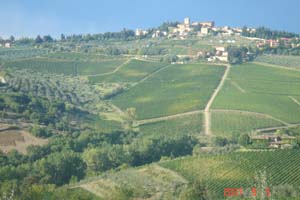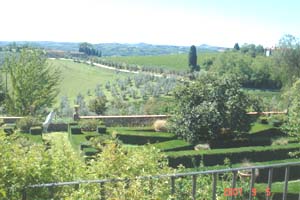 |
| A typical view of Chianti Classico vineyards from Fontodi Estate |
A friend's wife, who loves her husband immensely, faithfully loves Tuscan wines too. Ask her the difference between Chianti and Chianti Classico and you will draw a blank. Ditto for Tuscan wines and Chianti!
Perhaps a majority of wine drinkers don't know either. Chianti Classico is to Chianti what Chianti is to Tuscany and what Tuscany is to Italy, if you know what I mean.
It is a designated area, within Chianti, Tuscany, between Florence in the North and Siena in the South. It finds a very special place because of its terroir and personality when one talks of Tuscan wines. For understanding the geographical difference click, http://www.cecchi.net , the website of Cecchi, a renowned producer of Chianti Classico
It used to be a part of the Chianti DOCG appellation until August 5, 1996 when it became a separate Appellation through a government decree. Earlier, since 1984 the Classico was still considered a sub-denomination of Chianti DOCG, although with separate regulations that imposed production rules more stringent than those for Chiantis.
It is a common knowledge that Chianti was in doldrums during late sixties, seventies and even in the early eighties when it had become a notorious wine and a region for producing high yielding, cheap plonk bottled in special chianti fiascos (flasks). The producers started pulling up their socks to get the quality up, a process which still continues. Chianti is still synonymous with affordable quaff that washes down Tuscan cuisine well- better aged Riserva being an exception.
 |
| Olive trees and vineyards: A view from Principe Corsini Estate in San Casciano |
The new Chianti Classification appellation brought in different proportions of the grape blend to start with. The local grape, Sangiovese has to be 80%.-100% - which meant that producers could work only with this soul of Chianti grapes, if they so desired. Other regarded regions of Montalcino and Montepulciano in Tuscany could already use only Brunello and Prugnolo Gentile respectively, the highly rated variants of Sangiovese.
Producers are also allowed to use other indigenous red varieties like Canaiolo and Colorino; or the international varietals like Cabernet Sauvignon and Merlot, with a maximum of 20%.
Tuscan Trebbiano and Malvasia white, both white grapes, allowed in Chianti can no longer be used, beginning with the 2006 vintage. The minimum alcohol level is 12° for the regular wine and 12.5° for the Riserva.
Page 1 2 3 4 |